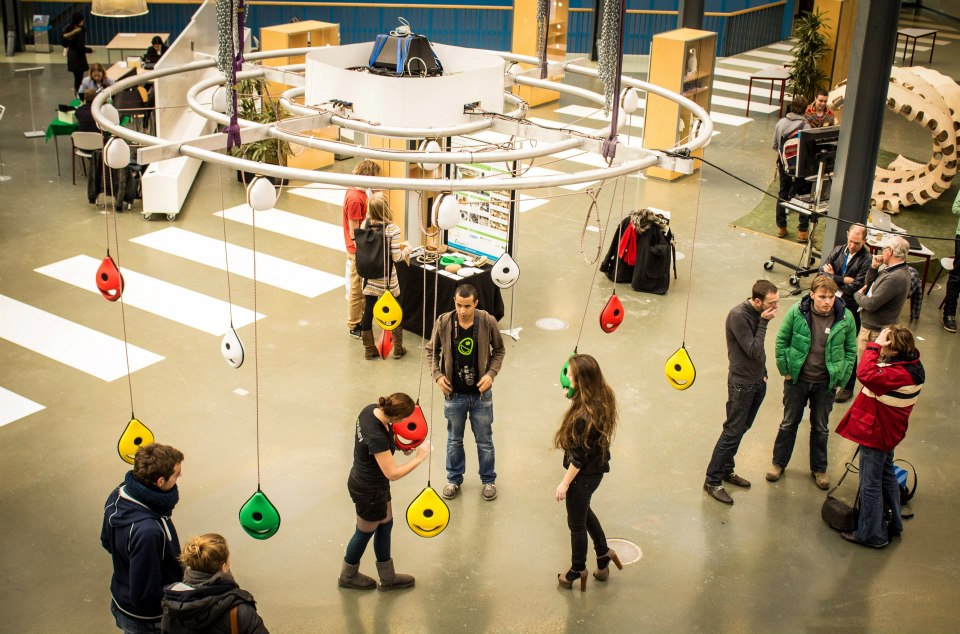
The Module
The eye of the populley functions as a speaker. The smiling mouth serves as a handgrip that can be pulled. The populleys notice and wake up when a child starts pulling them. Together they can create an everchanging experience of lights and sounds.
Module Fabrication
After the determination of the preliminary design of the populley, we needed to find the right materials for several components with the corresponding production method. The first design proposal considered the following demands:
– The double curved shape asked for a plastic material that can be formed in the right shape over and over again.
– The electronical parts needed to be supported by a constructional component and needed to remain accessible for maintenance.
The Fabrication, production and assembly methods reflects to the first design iteration and asked for a second design iteration. The thermoformed shape is mounted on a MDF construction frame, which is protected with a rubber profile for safety but also for finish.
The finish for the screws asked for a design solution in the appearance of the form. Dimples were added to the mouth corners to give the screw a flat mounting surface.
A mould in combination with thermoforming as a production method met the demand of a double curved shape. A mould was made out of MDF, planed by a CNC milling machine. Polystyrene was theremoformed over this mould into the desirable shape.
The populleys are build around an MDF lasercutted frame. In this picture the development of the prototype is visible At first there are only holes for the speaker and the grip…
… later the solutions for suspension, the extra frames for the stability + construction, and large L-shaped holes on both sides, so the light can come through, are added.
The Pulleys
Up in the air are the pulleys. They are a crucial piece in the suspension of the populleys and sensing the height of the modules. Every couple of populleys hangs from it’s own two pulleys that transfer force from the modules to the construction.
A pulley contains sensors that determine the height of the populley, by measuring the rotation of the inner wheel. On one side there is an arduino and two LDRs, that measure measure the amount of light coming through from 2 LEDs on the other side of the pulley.
As well as the modules, the pulleys have a thermoformed shell. After the mould was CNC milled, it had to be planed by hand. However the thermoforming of these shells was outsourced to save time.
Suspension Construction
The installation is suspended by an aluminium construction, consisting of a cross, supported by three circles. In the middle of this construction is a central monolith, the heart of populley.
This central unit is split into four quarters. The first quarter (furthest away on the picture) contains a computer that collects all the data from the arduinos in the pulleys and processes these signals into audio, using Max and Ableton (picture below).
These audio signals are send to two other quarters (on the sides of the picture). Here are the amplifiers for the sound and a sub-woofer for some body in the sound experience. Also a signal is send to the quarter in the front of the picture. Dimmers for the lights are placed here.
Usertesting
About 30 usertests were done while developing populley. Every user understood the grip usecue (the mouth) of the design, most children grabbing it with both hands. One of the things noticed was that children liked to play together with the installation. They also created their own games, like putting the populleys as high as possible for each other, so it’s impossible to grab for another.
This girl resembles pulling the populley as low as possible. What we really like about populley is that the level of physical activity is something you control yourself. Whether the children just walk around the installation, listening to the sound, or they go really crazy with pulling, jumping and running around.
Another thing that stood out while user testing was that children (and also adults) like to put the populley next to the ear to listen what sound is coming from the specific populley. The users try to explore the soundscape.
Design Team
Students: Jeroen Ubels, Bojana Dumeljic, Nathan van Schoote, Olav van der Doorn, Okke Willebrands, Mick van Rooijen , Mercedes Leipoldt, Edwin Sloot, Maartje van Zon, Dolores Hilhorst
Instructors: Chris Kievid, Aadjan van der Helm, Walter Aprile, Dieter Vandoren